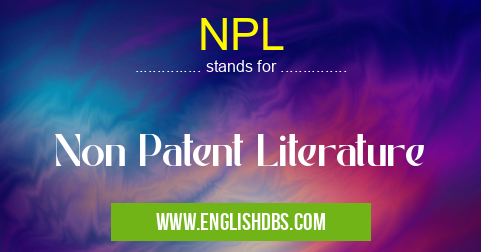What does NPL mean in PATENTS & TRADEMARKS
NPL (Non Patent Literature) refers to a comprehensive body of technical and scientific publications that are not protected by patents. These publications encompass a wide range of information, including:

NPL meaning in Patents & Trademarks in Business
NPL mostly used in an acronym Patents & Trademarks in Category Business that means Non Patent Literature
Shorthand: NPL,
Full Form: Non Patent Literature
For more information of "Non Patent Literature", see the section below.
- Conference proceedings
- Technical reports
- Dissertations
- Theses
- Market research reports
- Standards and specifications
- Government publications
NPL serves as a valuable resource for researchers, engineers, and business professionals seeking to access up-to-date information and insights on various technical and scientific domains.
NPL in Business
NPL plays a crucial role in business by providing:
- Market intelligence: NPL offers insights into industry trends, market dynamics, and competitive landscapes.
- Technology and innovation: NPL keeps businesses abreast of emerging technologies, advancements, and best practices.
- Regulatory compliance: NPL helps businesses stay informed about industry regulations and standards.
- Competitive advantage: Access to NPL enables businesses to gain insights that can drive innovation and create a competitive edge.
Essential Questions and Answers on Non Patent Literature in "BUSINESS»PATENTS"
What is Non-Patent Literature (NPL)?
Non-Patent Literature (NPL) encompasses a wide range of published materials that are not patents or patent applications. It includes scientific journals, conference proceedings, technical reports, theses, dissertations, and market research reports. Unlike patents, NPL is not subject to the same level of legal protection and does not grant exclusive rights to the inventor.
Why is NPL important in patent searching?
NPL is an invaluable resource for patent searching as it provides insights into the state-of-the-art in various technological fields. By examining NPL, patent examiners and researchers can identify prior art that may impact the patentability of an invention. Additionally, NPL can be useful for understanding the commercial viability and market potential of a technology.
What are the different types of NPL?
NPL encompasses a diverse array of publications, including:
- Scientific journals: Peer-reviewed publications that present original research findings and advancements.
- Conference proceedings: Collections of papers presented at scientific conferences, covering recent developments and industry trends.
- Technical reports: In-depth reports that document research findings, technical specifications, or project outcomes.
- Theses and dissertations: Graduate-level research papers that delve into specific topics and contribute to the advancement of knowledge.
- Market research reports: Analyses of market trends, customer behavior, and industry dynamics.
How can I access NPL?
NPL can be accessed through various online databases, libraries, and research institutions. Some popular resources include:
- Google Scholar: A comprehensive search engine for academic literature and NPL.
- PubMed: A database of biomedical and life sciences literature.
- IEEE Xplore: A collection of electrical engineering, computer science, and electronics publications.
- JSTOR: A digital library with a vast collection of scholarly journals and academic papers.
What are the benefits of using NPL in patent searching?
Utilizing NPL in patent searching offers several advantages:
- Prior art identification: NPL can help identify prior art that may anticipate or render obvious an invention claimed in a patent application.
- Technological landscape analysis: By reviewing NPL, researchers can gain insights into the current technological landscape, emerging trends, and potential areas for innovation.
- Market research: NPL can provide valuable information about market size, customer needs, and competitive dynamics, aiding in the assessment of the commercial viability of a technology.
Final Words: NPL is an indispensable resource that provides access to a wealth of technical and scientific information. By leveraging NPL, businesses and professionals can stay informed, make informed decisions, and foster innovation. Embracing NPL as a valuable tool can contribute to business success and advancement in various industries and disciplines.
NPL also stands for: |
|
| All stands for NPL |
